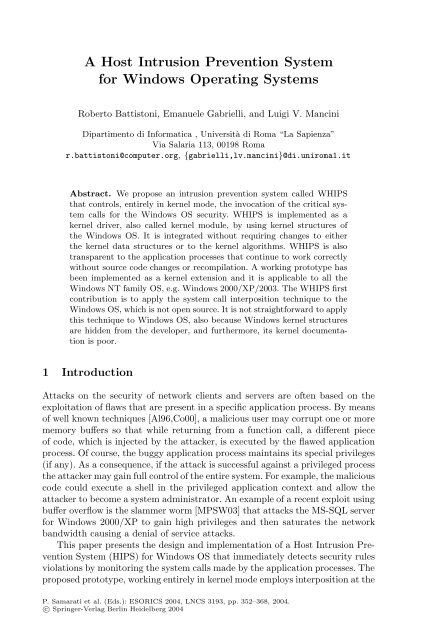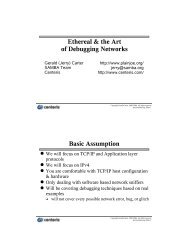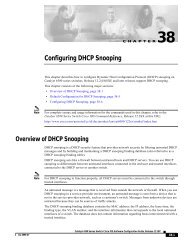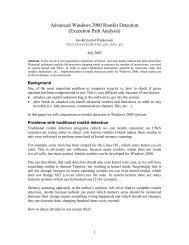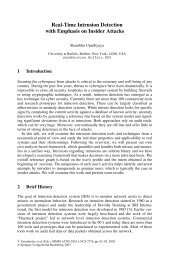A Host Intrusion Prevention System for Windows Operating Systems
A Host Intrusion Prevention System for Windows Operating Systems
A Host Intrusion Prevention System for Windows Operating Systems
Create successful ePaper yourself
Turn your PDF publications into a flip-book with our unique Google optimized e-Paper software.
354 Roberto Battistoni, Emanuele Gabrielli, and Luigi V. Mancini2.1 <strong>Windows</strong> Processes Security Context and PrivilegesThis section examines the Security Identity Descriptor (SID), the Access Token(AT) and the impersonation technique, which are the components of a processstructure that represents its security context. Then we examine the <strong>Windows</strong>privileges.Security Identity Descriptor: SIDs identify the entities that execute operationsin a <strong>Windows</strong> system and may represent users, groups, machines or domains.A SID contains a so-called RID (relative number) field that distinguishestwo SIDs otherwise equal in a <strong>Windows</strong> system. Every <strong>Windows</strong> system hasa lot of SIDs; some of them identify particular users or groups and are calledWell-Known SIDs [Mi02a].Access Token: The SRM (Security Reference Monitor) is a <strong>Windows</strong> kernelcomponent that uses a structure called Access Token to identify a thread or aprocess security context [RuS01]. A security context is a set of privileges, usersand groups associated to a process or a thread. During the log-on procedure,Winlogon builds an initial token that represents the user rights, and links thistoken to the users shell process. All the processes created by the user inherita copy of the initial AT. We have two types of AT: primary token and impersonationtoken. Every process has an AT called primary token. Every process in<strong>Windows</strong> has associated a primary thread and a variable number of secondarythreads that executes the process operations. The primary thread inherits acopy of the primary token, whereas a secondary thread may inherit a copy ofthe primary token, or may obtain a restricted copy of the primary token by theimpersonation mechanism.Impersonation: It is a mechanism that allows a security context of a process ora thread to migrate in another security context. For example, an impersonationoccurs when a server accesses its resources on behalf of a client. In this case, theimpersonation mechanism allows the server process to use the security context ofthe client that requested that particular operation [RuS01]. To avoid an improperuse, <strong>Windows</strong> does not permit to a server to impersonate a client process withoutthe client consensus. Some impersonation levels follow: SecurityAnonymous, SecurityIdentification,SecurityImpersonation, SecurityDelegation. If a client doesnot choose an impersonation level, SecurityImpersonation is the default.<strong>Windows</strong> Privileges: A privilege in <strong>Windows</strong> is the right to operate on aparticular aspect of the entire system, so a privilege acts on the entire system,whereas a right acts on an object of the system [Scm01]. A privilege may beassigned to a user or a group in <strong>Windows</strong>. When a user logs on a <strong>Windows</strong>system, a process will be created and assigned to the user, then the privilegesassigned to the user or the group will be added in the AT privileges list of the userprocess. There are many privileges in <strong>Windows</strong>, each allowing a particular actionon the system, but not every privilege is dangerous <strong>for</strong> the system security. Onlya subset of the entire set of <strong>Windows</strong> privileges contains dangerous privilegesthat can be exploited by a malicious user.
A <strong>Host</strong> <strong>Intrusion</strong> <strong>Prevention</strong> <strong>System</strong> <strong>for</strong> <strong>Windows</strong> <strong>Operating</strong> <strong>System</strong>s 357Fig. 1. <strong>System</strong> Service Table (SST)NtCreateFile:mov eax,0x0000001Alea edx,[esp+04]int 0x2Eret 0x2CFig. 2. NTCreateFile assembly codethere are the parameters of native API, and finally raises interrupt 0x2E thatexecutes the <strong>System</strong> Service Dispatcher of <strong>Windows</strong>. <strong>System</strong> Service Dispatcheris the kernel routine that invokes the true native API in the kernel. Not all thenative API exported by Ntdll.dll are exported by ntoskrnl.exe. Thisseemstoprevent the unauthorized use of particular and dangerous native APIs withinany module implemented as a kernel driver. Disassembling the library ntdll.dll,we can observe that every Nt native API and its corresponding Zw native APIhave the same assembly code, fig. 2. If we disassemble ntoskrnl.exe, the true nativeAPIs with the Nt prefix contain the true code of native API, and the nativeAPIs with the Zw prefix have the representation in the example of figure 2, seealso [Ne00,Osr03,Scr01] <strong>for</strong> details.<strong>System</strong> Service Dispatcher. Dispatcher of interrupt 0x2E is the <strong>System</strong> ServiceDispatcher routine. It is implemented in the executive layer of the <strong>Windows</strong>kernel, through the kernel function Ki<strong>System</strong>Service. APIsingdi32.dll anduser32.dll call directly the dispatcher Ki<strong>System</strong>Service, and after the dispatcherinvokes functions in win32k.sys module. The APIs in kernel32.dll invoke the
358 Roberto Battistoni, Emanuele Gabrielli, and Luigi V. Mancinifunctions exported by ntdll.dll and then these exported functions call the nativeAPIs in <strong>Windows</strong> kernel. When Ki<strong>System</strong>Service is invoked, the dispatcher runsa series of checks. First, it controls the validity of index passed in EAX register,then it controls if the argument space expected <strong>for</strong> the native API parametersis correct and finally executes the native API in the kernel. When Ki<strong>System</strong>Serviceinvokes the native APIs, it uses a structure called <strong>System</strong> ServiceDescriptor Table (SDT), represented by the KeServiceDescriptorTable structure[Scr01,HLB01]. KeServiceDescriptorTable has two table pointers: KiServiceTable(<strong>System</strong> Service Table, SST) andKiArgumentTable. The first table contains anindex <strong>for</strong> every native API, used by native API code in ntdll.dll, toinvokethecorresponding native API in the kernel. The second table contains, <strong>for</strong> everynative API, the allocation space <strong>for</strong> this API parameters. This space is used <strong>for</strong>the kernel-stack memory allocation.Critical and Dangerous Native APIs. A native API can be considered asa <strong>Windows</strong> system call. But when is a system call in <strong>Windows</strong> a critical systemcall? A native API is a generic kernel function; it has a function name, a seriesof parameters and a return value. If we consider a native API by itself, it is notcritical, but it becomes critical when it has dangerous parameters. Consider asimple example: the native API NtOpenFile. Typically this native API opens ahandle to a file on the File <strong>System</strong>. Its only parameter is a pointer to a stringthat represents the file name (with path) that will be opened. If the file name isreadme.txt, this native API is not critical <strong>for</strong> the system. But, if the file to open isequal to c:\winnt\cmd.exe, the <strong>Windows</strong> shell, NtOpenFile with this particularparameter is critical because it could be used to open a system administrativesession.Soweintroducesomedefinition:Definition 4. A parameter of a Native API is dangerous if it can be used by amalicious user to compromise the availability, the confidentiality and the integrityof the system.Definition 5. A critical system call is a native API that could be invoked withdangerous parameters.Definition 6. A dangerous system call is a critical system call invoked by adangerous process.Note that a critical system call is dangerous <strong>for</strong> the system only if the invokingprocess is a dangerous process. A dangerous process that calls a native API withdangerous parameters may represents an attack of a malicious user.Native API Classification. Native APIs in <strong>Windows</strong> 2000 and XP are about250, and only 25 of them are documented by Microsoft within the Driver DevelopmentKit (DDK). All others native APIs are not documented. A goodsupport <strong>for</strong> native API documentation is <strong>Windows</strong> NT/2000: Native API reference[Ne00] which is not an official Microsoft documentation of <strong>Windows</strong> OS.
A <strong>Host</strong> <strong>Intrusion</strong> <strong>Prevention</strong> <strong>System</strong> <strong>for</strong> <strong>Windows</strong> <strong>Operating</strong> <strong>System</strong>s 359Fig. 3. WHIPS Reference MonitorTable 1 represents a first classification of native APIs by category (21 categories)which is derived from [RuS01,Ru98], and shows that in <strong>Windows</strong> we have manysystem calls. Linux give us more in<strong>for</strong>mation with its source code on its systemcalls, whereas <strong>Windows</strong> does not give us any in<strong>for</strong>mation on its system call.3 The WHIPS PrototypeWHIPS is a Reference Monitor (RM) <strong>for</strong> the detection and the prevention of<strong>Windows</strong> dangerous system calls invocation. This prototype is based on an initialidea related to the REMUS Project [BGM02]. REMUS is a RM <strong>for</strong> LinuxOS and it is implemented with a dynamic loadable module of Linux kernel.WHIPS is implemented as a kernel driver, also called kernel module, using undocumentedstructure of <strong>Windows</strong> kernel and the routines typically employed <strong>for</strong>drivers development [BDP99]. The WHIPS prototype can be seen as a systemcall RM <strong>for</strong> <strong>Windows</strong> and the implementation technique utilized is the systemcalls interposition. As you can see in Figure 3, WHIPS is a module that filtersevery critical system call invoked by a <strong>Windows</strong> service and establishes if thecritical system call is dangerous by checking its actual parameters. If the systemcall is not dangerous it will be passed to the kernel <strong>for</strong> the execution, otherwiseit will be stopped and not executed. RM control policies are established by asmall database called Access Control Database (ACD).The ACD defines the allowed actions on the system by means of a set of rules.Every time a dangerous process invokes a critical system call through ntdll.dll ora wrapper (a code that rise int 0x2E), the call of the process is checked by WHIPSthat matches the process name, the critical system call with its parameters, with
360 Roberto Battistoni, Emanuele Gabrielli, and Luigi V. ManciniTable 1. Native API categoriesIndex Category Description1 Special Files These APIs are used to create filesthat have custom characteristics.2 Drivers These functions are used by NT to load and unloaddevice driver images from system memory.3 Processorand BusProcessor registers and components can be controlledvia these functions.4 Debuggingand ProfilingThe profiling APIs provide a mechanism <strong>for</strong>sample-based profiling of kernel-mode execution.5 Channels Provide access to a communications mechanism.6 Power Native API <strong>for</strong> power management.7 Plug-and-Play Like the Power API.8 Objects Object manager namespace objects are createdand manipulated with these routines.9 Registry Win32 Registry functions basically map directlyto these APIs.10 LPC LPC is NT core interprocess communications mechanism.11 Security The Native security APIs are mapped almost directlyby Win32 security APIs.12 Processesand ThreadsThese functions control processes and threads.Many have direct Win32 equivalents.13 Atoms Atoms allow <strong>for</strong> the efficient storage andreferencing of character strings.14 Error Handling Device drivers and debuggers rely on these errorhandling routines.15 ExecutionEnvironmentThese functions are related to generalexecution environment.16 Timers and<strong>System</strong> TimeVirtually all these routines have functionalityaccessible via Win32 APIs.17 Synchronization Most synchronization objects have Win32 APIs,with the notable exception of event pairs.Event pairs are used <strong>for</strong> high-per<strong>for</strong>manceinterprocess synchronization by the LPC facility.18 Memory Most of NT virtual memory APIs are accessiblevia Win32.19 File andGeneral I/OFile I/O is the best documented of the native APIssince many device drivers must make use of it.20 Miscellaneous These functions do not fall neatly into other categories.21 Jobs These functions are essentially a group ofassociated processes that can be controlled as a singleunit and that share job-execution time restrictions.the ACD rules. If a rule exists that satisfies this invocation, the native API isexecuted otherwise is not executed because the system call invoked is classifiedas dangerous.
A <strong>Host</strong> <strong>Intrusion</strong> <strong>Prevention</strong> <strong>System</strong> <strong>for</strong> <strong>Windows</strong> <strong>Operating</strong> <strong>System</strong>s 361Fig. 4. WHIPS implementation architectureThe implementation technique used by WHIPS, suggested by [CRu97,BDP99],replaces the native APIs pointers in the <strong>System</strong> Service Table (fig. 4), withpointers to the new native APIs supplied by the prototype. The new nativeAPIs are wrappers to original native APIs and implement the RM checks.For every original critical native API we have introduced a new native API,which has the same function name with a prefix New (ex. NewNtCreateFile). Thisnew API analyzes its invoking process and its parameters. If the invoking processis dangerous and the native API is critical, a check is per<strong>for</strong>med on the actualparameters considering the rule in the ACD. If there is not a corresponding rulein the ACD the original native API is not invoked, since the native API may bedangerous. Otherwise it is invoked and executed.3.1 Access Control DatabaseThe ACD is implemented by a simple text file (protected by the system ACL andaccessible only to the Administrator or Administrative groups). ACD is loadedat the driver start-up and it is allocated entirely in main memory; no otheraccesses are needed to the file and this avoid per<strong>for</strong>mance problem. A genericrule in the ACD is represented in table 2.These ACD rules state that Process can execute the specific Native API withthe specific Param[1..N]. The specification of the rules to insert into the ACD ispossible in a manual or automatic manner. In the first case, the administrator ofthe system must specify all the Native APIs critical and allowed <strong>for</strong> the system.This can be done with approximation, step by step, but a period of control of thesystem is necessary. In fact some omissions could prevent the correct operationof some application.
362 Roberto Battistoni, Emanuele Gabrielli, and Luigi V. ManciniTable 2. ACD Rule schemaRule Type Process name Native API Name ParamAPI [1..n]– Rule Type: can be debug or rule; when the type is rule, this means that the rulefilters the execution of system call. When the type is debug, the execution of acritical system call will be traced but not blocked.– Process Name: is the name of the executable image that has activated the dangerousprocess; this name is a string that identifies only the name and not thecomplete path; WHIPS prototype works entirely in kernel-mode and it has notaccess to process block to retrieve the complete path of executable image becausethis in<strong>for</strong>mation is accessible only in user-mode.– Native API: is the name, with prefix Nt, of the critical native API invoked byProcess.– Param [1..N]: are the legal actual parameters of the critical system call.The second case is to implement a robot that analyzes all the system callsinvoked by the system in a trusted environment and create the correct rules <strong>for</strong>the ACD.The per<strong>for</strong>mance of the system depends on the number of rules in the ACDand how the matching algorithm is implemented. In this first prototype the ACDis scanned sequentially with a computational cost of O (n), where n is the numberof rules in the ACD. In a preliminary study we have estimated that the number ofthese rules is not more than 1000, so the sequential search seems computationalacceptable. Alternatively one could implement other more efficient algorithmsto lower the computational cost of the rule search.3.2 <strong>System</strong> Service Table ModifiedWHIPS is a kernel module, also called a driver in <strong>Windows</strong>. Now we examine aC-like representation of the source code that implements the patch to the <strong>System</strong>Service Table (SST) of <strong>Windows</strong>. The main function of the WHIPS prototype isthe common main function of all the drivers in <strong>Windows</strong> OS, called DriverEntry.In WHIPS,this function does not drive any peripheral of the system and the onlywork that it does is calling the HookServices function at driver start-up.Figure 5 shows the C-like representation of the <strong>System</strong> Service Table (SST)patch. The first operation that it does is to load the ACD database in the kernelmemory with LoadDB, and then it patches the SST. With macro SYSTEMSER-VICE, theHookServices function saves the old references to the native APIs inOldNtApiName, and then substitutes the old references in the SST with the newreferences to the new native APIs supplied by the prototype.3.3 New Native API ImplementationTo explain the implementation of the new native APIs, figure 6 shows the representationin C-like of the NewNtOpenProcess. When a process wants to call the
A <strong>Host</strong> <strong>Intrusion</strong> <strong>Prevention</strong> <strong>System</strong> <strong>for</strong> <strong>Windows</strong> <strong>Operating</strong> <strong>System</strong>s 363HookServices() {LoadDB("RmDB.rbt", &ruleArrayRM, &numruleRM);OldNtCreateFile=SYSTEMSERVICE(ZwCreateFile);..OldNtClose=SYSTEMSERVICE(ZwClose);Disable Interrupt;SYSTEMSERVICE(ZwCreateFile)=NewNtCreateFile;..SYSTEMSERVICE(ZwClose)=NewNtClose;Enable Interrupt;return;}Fig. 5. WHIPS Patch functionNtOpenProcess, it really calls the corresponding new native API NewNtOpen-Process. The new native API detects its invoking process name and its onlyparameter: the process name that will be opened by the native API. Then theNewNtOpenProcess stores this data in a temporary rule called rule. The<strong>for</strong>matof this temporary rule is similar to the <strong>for</strong>mat of the rules in the ACD, this isto simplify the check of the rule.Next the procedure evaluates if the invoking process is a dangerous process.The function isProcessDangerous analyzes the AT of the invoking process andreturn true iftheprocessisdangerous,false otherwise. Remember that in thisversion of the prototype dangerous processes are <strong>Windows</strong> services or <strong>Windows</strong>system processes (refer to section 2.2). The function VerifyDebugNativeAPI analyzesif the native API must be traced in the debug environment, whereasVerifyNativeApi looks into the ACD database to find a rule that allows the executionof the invoked API. Only if this function return true, original native APIis called with the invocation of OldNtOpenProcess saved in HookServices.3.4 Prototype EffectivenessThe WHIPS prototype can be tested with the Web Server File Request Parsingvulnerability of IIS in <strong>Windows</strong> NT/2000 up to Service Pack 2. This vulnerabilitypermits to execute shell command in a web browser with an URL not well<strong>for</strong>med.If <strong>for</strong> example, we call the URL:http://host/scripts/..%255c..%255cwinnt/system32/cmd.exe?/c+dir+c:We obtain a shell that shows the list of files of the C: partition hard drive.But, this vulnerability may become very dangerous if a shell command is passedas an argument to delete or to modify some configuration files not protected bythe ACLs. Now we explain how this vulnerability works.The Web Server IIS, inetinfo.exe, executes in its thread the shell command<strong>for</strong> an incorrect interpretation of the URL <strong>for</strong>mat. This thread has IUSR HOST
364 Roberto Battistoni, Emanuele Gabrielli, and Luigi V. ManciniNewNtOpenProcess(phProcess,...,pClientId) {startTimeO=KeQueryPer<strong>for</strong>manceCounter(&frequency);GetProcess(currProc);GetProcessByProcessID(pClient,pClientId);rule.processName=currProc;rule.api="ntopenprocess";rule.numparam=1;rule.api param[0]=pClient;CurrentProcessIsDangerous=isProcessDangerous();if (VerifyDebugNativeAPI(rule,CurrentProcessIsDangerous))Print Debug In<strong>for</strong>mation;if (VerifyNativeAPI(rule,CurrentProcessIsDangerous)) {endTimeO=KeQueryPer<strong>for</strong>manceCounter(&frequency);Show Overhead In<strong>for</strong>mation;OldNtOpenProcess(phProcess,...,pClientId);} else {endTimeO=KeQueryPer<strong>for</strong>manceCounter(&frequency);Show Overhead In<strong>for</strong>mation;}return;}Fig. 6. WHIPS New Native API implementationprivileges (guest privileges). So the Web server erroneously executes code out ofthe web server directory. In other situations, the attacker could obtain administratorprivileges if the threads owned by a process have the same privileges ofthe administrator.If WHIPS prototype is running, the thread created by privileged processinetinfo.exe is analyzed. In the ACD database is not present a rule <strong>for</strong> the nativeAPI NtOpenFile with shell (cmd.exe) parameters, <strong>for</strong> IIS privileged process (andits threads), so the execution of the native API is stopped and also the attack tothe Web server. This experiment shows that WHIPS permits only the allowedNative APIs to operate on the systems, and consequently stops every maliciousactions of the dangerous processes.3.5 Per<strong>for</strong>mance EvaluationThe actual impact of WHIPS on the global system per<strong>for</strong>mance is negligible <strong>for</strong>all practical purposes, mainly because the number of critical system call invocationsis small with respect to the total number of instructions executed by a process.However, in order to evaluate even the minimal overhead introduced by theWHIPS prototype, we have devised further experiments based on micro benchmark.In particular, the kernel function KeQueryPer<strong>for</strong>manceCounter exportedby the kernel is used. KeQueryPer<strong>for</strong>manceCounter(Per<strong>for</strong>manceFrequency) returnsthe clock ticks counter (#tick) from system boot, whereas the clock tickcounter per second (#tick/sec) is expressed by Per<strong>for</strong>manceFrequency. Ageneric
A <strong>Host</strong> <strong>Intrusion</strong> <strong>Prevention</strong> <strong>System</strong> <strong>for</strong> <strong>Windows</strong> <strong>Operating</strong> <strong>System</strong>s 365invocation time T i of the kernel function KeQueryPer<strong>for</strong>manceCounter is givenin microseconds by:T i =#tick iPer<strong>for</strong>manceFrequency . (1)Now assume that ∆T is the execution time of a generic code block betweentwo invocations of KeQueryPer<strong>for</strong>manceCounter. These two invocations determinerespectively T 1 and T 2 ,whereT 1 is the first invocation time and T 2 is thesecond invocations time, and ∆T =T 2 -T 1 .We must consider that the execution of the function KeQueryPer<strong>for</strong>mance-Counter introduces an overhead too, we call this ∆T OverheadKeQuery .Toestimate∆T OverheadKeQuery , we have measured two consecutive invocations ofKeQueryPer<strong>for</strong>manceCounter.We define the elaboration block as the WHIPS code block that implementsthe control of the native API parameters and the control on the invoking process.The overhead introduced by a generic new native API is:∆T OverheadNewNAPI=(T 2,OverNewNAP I − T 1,OverNewNAP I ) − ∆T OverheadKeQuery , (2)whereas the execution time of the original native APIs in <strong>Windows</strong> is called∆T NativeAPI which is computed measuring a native API execution in a waysimilar to equation 2.3.6 MeasurementsThe system utilized <strong>for</strong> the measurement is a PC with AMD Athlon CPU,with clock frequency of 1200 Mhz, 512 Mbytes of RAM and <strong>Windows</strong> 2000OS. We have measured only four native API and specifically three critical nativeAPI: NewNtOpenFile, NewNtCreateFile and NewNtOpenProcess, andonenot critical, NewNtClose. For every native API, intercepted by the WHIPS prototype,we have done a significant number of measurements (∼10.000), and wehave elaborated these to obtain the average times without spiced values. Wehave determined ∆T OverheadNewNativeAP I , the average overhead introduced byeach new native API, and ∆T NativeAPI , the average time of the original nativeAPI. The average overhead of function KeQueryPer<strong>for</strong>manceCounter, called∆T OverheadKeQuery ,is∼0,82 µsec on our test PC.Table 3 compares the execution time of the original native API (A) withthe overhead introduced by the corresponding new native API (O). This is tomeasure the impact of the WHIPS prototype implementation respect to theoriginal system. As you can see, all the overheads (O) are almost the same invalue, except <strong>for</strong> the NtClose case, because NewNtClose per<strong>for</strong>ms few operationsin the elaboration block; in fact these new APIs determine the name of the processor the handle passed to them. The last column (I) shows the percentage incidenceof the new native API overhead on the execution time of the original native API.
366 Roberto Battistoni, Emanuele Gabrielli, and Luigi V. ManciniTable 3. Comparative table ApiTime and OverheadTimeAPI Average Execution Time API IncidenceAPI Time (A)∆T NativeAPIOverhead Time (O)∆T OverheadNewNativeAP I%Overhead(I)I: O/A*100NtClose 7,68 µsec 6,37 µsec 83%NtCreateFile 246,74 µsec 21,52 µsec 9%NtOpenFile 53,56 µsec 20,67 µsec 39%NtOpenProcess 8,49 µsec 23,23 µsec 274%Fig. 7. Overhead and Api Time ratioThe figure 7 shows a line chart with percentage incidence (I) ofeverynativeAPI intercepted by the WHIPS prototype. As you can see the highest is theNewNtOpenProcess case that introduces an overhead of 274% respect to NtOpen-Process execution time. Lowest incidence is of NewNtCreateFile that introducesan overhead of 9% respect to NtCreateFile execution time. In figure 8 you cansee a comparative line chart between the overhead introduced by new nativeAPIs (O) and the execution time of the original native API (A). Higher is thedifference from the overhead and the execution time and higher is the percentageincidence (I). If we consider the NtClose, we have a minimum difference, andthis means that the overhead introduced by WHIPS is close to the executiontime of the original native API. In the case of NtCreateFile the overhead is lessthan the execution time and the incidence is low. In NtOpenProcess the overheadis bigger than the original native API execution time and the incidence is high.4 Concluding RemarksOur work defines privileged processes in <strong>Windows</strong> OS and proposes a methodologyto discover the processes that can be dangerous <strong>for</strong> the system. Identifying
A <strong>Host</strong> <strong>Intrusion</strong> <strong>Prevention</strong> <strong>System</strong> <strong>for</strong> <strong>Windows</strong> <strong>Operating</strong> <strong>System</strong>s 367Fig. 8. Overhead and Api Timedangerous processes is the first and most important step in the design of thistype of HIPS. The Access Token (AT) privileges list of a process can be used toidentify if a process is dangerous. In particular, if in the AT privileges list thereare one or more dangerous privileges, the process, owner of the AT, belongs tothe set of dangerous process. For simplicity in this paper we have focused ona subset of dangerous process: the <strong>Windows</strong> Services. The relation between thedangerous processes and the critical system calls leads to the concept of dangeroussystem calls (see section 2.3). The implementation of the WHIPS prototypeis based on the above concepts. WHIPS stops common exploits that use thebuffer overflow technique to carry out the privilege escalation on a system. Ifa malicious user wants to execute a shell in a context of the exploited service,WHIPS will prevent the attack by stopping the execution of the dangerous systemcall that invokes the shell.Future research will include the inspection of the entire native API in <strong>Windows</strong>OS, <strong>for</strong> a full classification of the system calls. Another step could beto implement a Web-service like <strong>Windows</strong> Update, namedWHIPS Update thatallows the user to download new sets of rules in order to configure the ACDautomatically. This simplifies the definition of the rule in the ACD database.WHIPS could be even more efficient if it were implemented directly into the<strong>Windows</strong> kernel, instead of as a kernel driver, but in order to do so the sourcecode of the <strong>Windows</strong> kernel must be accessed.AcknowledgmentsThe authors gratefully acknowledge dr. R.Bianco <strong>for</strong> the helpful discussions andthe anonymous reference <strong>for</strong> their helpful comments. This work is funded by the
368 Roberto Battistoni, Emanuele Gabrielli, and Luigi V. ManciniItalian MIUR under the projects: FIRB WEB-MINDS and PRIN 2003 WEBbasedmanagement and representation of spatial and geographic data.References[Al96] Aleph One, Smashing the stack <strong>for</strong> fun and profit, Phrack Magazine, vol 49,1996.[BGM02] Bernaschi, Gabrielli, Mancini, REMUS: a security-enhanced operating system,ACM Transactions on In<strong>for</strong>mation and <strong>System</strong> Security, Vol. 5, No. 1, pp. 36-61,Feb. 2002. http://remus.source<strong>for</strong>ge.net/.[BDP99] Borate, Dabak, Phadke, Undocumented <strong>Windows</strong> NT, M&T Books, 1999.[CRu97] Cogswell, Russinovich, <strong>Windows</strong> NT <strong>System</strong>-Call Hooking, Dr. Dobb’s Journal,p. 261, 1997.[Co00] Cowan et al, Buffer Overflows: attacks and defences <strong>for</strong> the vulnerability of thedecade, Proc. IEEE DARPA In<strong>for</strong>mation Survivability Conference and Expo, HiltonHead, South Carolina, 2000.[Ep00] Epstein et al., Using <strong>Operating</strong> <strong>System</strong> Wrappers to Increase the Resiliency ofCommercial Firewalls , Proc. ACM Annual Computer Security Applications Conference,Louisiana, USA, Dec. 2000.[HLB01] Howard, LeBlanc, Writing Secure Code, Microsoft Press, 2001.[MPSW03] Moore, Paxson, Savage, Shannon, Stani<strong>for</strong>d, Weaver, Inside the slammerworm, IEEE Security&Privacy, pp.33-39, July-August 2003.[Mi02a] Microsoft, Well-Known Security Identifiers in <strong>Windows</strong> 2000, KnowledgeBase 243330, 2002, http://support.microsoft.com/default.aspx?scid=KB;EN-US;Q243330&.[Ne00] Nebbet, <strong>Windows</strong> NT/2000: Native API reference, Macmillan Technical Publishing(MTP), 2000.[Osr03] OSR Open <strong>System</strong> Resources Inc, Nt vs. Zw - Clearing Confusion On TheNative API, The NT Insider, Vol 10, Issue 4, August 2003.[RuS01] Russinovich, Solomon, Inside <strong>Windows</strong> 2000: Third Edition, Microsoft Press,2001.[Ru98] Russinovich, Inside the Native API, <strong>System</strong>s Internals, 1998,http://www.sysinternals.com/ntdll.htm.[Scm01] Schmidt, Microsoft <strong>Windows</strong> 2000 Security Handbook, Que Publishing, 2001.[Scr01] Schreiber, Undocumented <strong>Windows</strong> 2000 Secrets, Addison Wesley, 2001.


